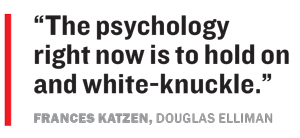Trending
Gut checking real estate’s interest rate fears
As new Fed chair Jerome Powell takes over from Janet Yellen this month, should the industry worry about rising interest rates?

Federal Reserve chairs have the power to put financial markets in a frenzy with a few seemingly harmless phrases. In June 2013, then-Fed Chair Ben Bernanke stepped to the microphone for a regular press conference and suggested the central bank might start winding down its bond-buying program — first enacted in the wake of the 2008 financial crisis — if the economy continued to improve.
Immediately after he spoke, the Dow Jones Industrial Average fell by more than 100 points. A day later residential mortgage rates rose to 4.25 percent, up from 4.12 percent at the time of the conference and 3.5 percent that May. And in CMBS land, spreads on investment-grade triple-B bonds surged by 158 basis points between May and June.
The so-called taper tantrum of mid-2013 eventually subsided, but the real estate industry suffered from aftershock. It was, after all, a timely reminder of how much impact a sudden hike in interest rates can have.
Four and a half years later, fear of another unexpected move by the Fed is palpable. And this time the stakes are even higher. After nine years of growth, the robust real estate cycle in the country’s top markets seems to be well beyond its peak, and a sudden rise in interest rates could accelerate a downturn.
Amid all that uncertainty, a new Fed chair is set to take over in early February.
For the first time in history, the president of the United States didn’t ask a sitting Fed chair to renew his or her term. With Janet Yellen out the door, Jerome Powell, a current Fed governor and former investment banker, is set to take the helm of the powerful institution this month.
But should the real estate industry be worried about a change in monetary policy?
 “I think that people are frightened of the unknown,” said Douglas Elliman broker Frances Katzen, who added that she’s noticed more homeowners trying to refinance or lock in fixed-rate mortgages in anticipation of rate hikes.
“I think that people are frightened of the unknown,” said Douglas Elliman broker Frances Katzen, who added that she’s noticed more homeowners trying to refinance or lock in fixed-rate mortgages in anticipation of rate hikes.
That’s compounded by fears in the residential market over the GOP tax overhaul — which makes it harder to deduct property taxes and mortgage interest from federal income taxes.
“The psychology right now is to hold on and white-knuckle,” Katzen said.
Rate aid
Talk to any real estate insider about the state of the market, and the conversation will inevitably turn to interest rates. Low rates mean cheaper debt, which makes it easier for investors to buy commercial and residential properties. They also make other investments like bonds less appealing, enticing more people to invest in buildings.
Over the past nine years, 30-year mortgage rates have hovered at historical lows below 5 and even 4 percent and were a key reason New York City’s real estate industry recovered so well from the 2008 crisis. But while rising long-term rates can be bad news for the industry, they don’t have to be.
“The question is: How fast do they rise?” said Andrew Dansker, a commercial mortgage broker at Marcus & Millichap.
If rates rise slowly amid a growing economy, higher corporate earnings and wages will counterbalance any negative impact on demand for real estate. But if rates rise too quickly or unexpectedly, they can do real damage. Hence the industry’s Fed anxiety.
When Newmark Knight Frank’s December IPO disappointed at $14 a share rather than the firm’s anticipated $19 to $22, for example, analysts blamed investor fears that rising interest rates would harm the commercial real estate market.

Grant Long
The good news is that Powell will likely stick with his predecessor’s cautious approach, observers say.
Yellen has been widely considered a dove — she was willing to accept low interest rates for an extended period of time in a bid to create job and wage growth. During her four-year term, the Fed raised interest rates five times as the economy improved but kept them at historically low levels, defying hawks who wanted faster rate increases to stave off any risk of runaway inflation and asset bubbles.
Powell, who was one of the 11 people to vote on the rate increases as a Fed governor, did not dissent once. “We’ve been patient in removing accommodation, and I think that patience has served us well,” he said during a hearing before the Senate Banking Committee in November 2017.
Savills Studley’s chief economist, Heidi Learner, said the leadership change “could have been important if [the new Fed chair] had been someone else.” As it stands, she argued, little will change.
Predictability is the key word — the central bank is expected to raise interest rates up to three times in 2018, but the moves will likely have little impact because the markets already anticipate them, observers say. “The Fed learned its lesson from the taper tantrum,” Learner maintained.
CoreLogic economist Sam Khater said he expects mortgage rates to go up by 50 basis points this year and, in a worst-case scenario, by 100 basis points. He argued that the real estate industry’s interest rate anxiety is misguided.
“Yes, there’s fear, but that fear has been there for the last 15 or 20 years,” Khater said. “It’s almost like yelling ‘fire’ in a movie theater. If they do it enough times and there is no fire, then you just don’t believe them.”
Broken system?
Even if, defying expectations, Powell turns into a hawk, his actions may not matter as much because the Fed arguably has less control over interest rates now than it did in the past.
The central bank doesn’t set rates by fiat, but instead influences them through a complicated set of mechanisms.
The key tool is the federal funds rate — the interest rate banks charge each other for overnight loans. The Fed can raise or lower its target for that benchmark rate, which it controls by buying and selling bonds. A higher federal funds rate often leads to higher long-term interest rates like the 10-year Treasury and mortgage yields, which matter a lot to the real estate industry.
But those mechanisms don’t always work.
In recent years, as the Fed raised short-term rates repeatedly, long-term rates barely budged and in some cases even fell, the main cause being the broader global economy. As central banks in other countries lowered their rates, money flowed into the U.S., pushing yields down.
“What we learned in 2013 is that we don’t live on an island,” said Jim Glassman, head economist at JPMorgan Chase’s commercial banking division and a former Fed economist. “Once the Fed started shrinking its balance sheet, many people thought the long-term rates would go up, and they haven’t. So now people are thinking maybe there’s something bigger going on around here.”
In other words: What Powell’s Fed does may not matter as much as long as foreign money keeps flowing into the country.
But that doesn’t mean the real estate industry can safely ignore the central bank. One risk, sources say, is that the U.S. economy may grow faster than expected, which would likely cause inflation to surge. That could force the Fed to keep it in check by raising rates more aggressively. The recently passed federal tax reform — a deficit-financed fiscal stimulus — makes this scenario more likely.
“We are in the late innings of an expansion and it’s not, by the book, the right time to apply fiscal stimulus,” said Grant Long, a senior economist at StreetEasy and former analyst at the Federal Reserve Bank of New York. The tax overhaul, among other things, could lead to an overheated economy, which would “force the Fed to raise rates more rapidly,” he said.
Another risk factor is that the central bank still owns about $1.8 trillion in mortgage-backed securities from its post-2008 bond-buying spree, Long noted. So what if the Fed’s new Board of Governors decided to start selling those at a faster pace?
“That,” he said, “would have a very, very dramatic effect on long-term rates.”




